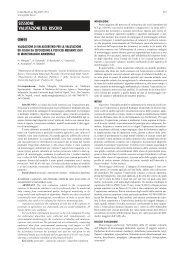28° Congresso Internazionale ICOH - Giornale Italiano di Medicina ...
28° Congresso Internazionale ICOH - Giornale Italiano di Medicina ...
28° Congresso Internazionale ICOH - Giornale Italiano di Medicina ...
Create successful ePaper yourself
Turn your PDF publications into a flip-book with our unique Google optimized e-Paper software.
222 G Ital Med Lav Erg 2006; 28:2<br />
www.gimle.fsm.it<br />
CONCLUSIONI<br />
Nel campione <strong>di</strong> soggetti in esame (ve<strong>di</strong> Tabella I), si<br />
è riscontrato, pure nel breve periodo <strong>di</strong> osservazione, un<br />
generale miglioramento del livello <strong>di</strong> fitness car<strong>di</strong>ocircolatorio:<br />
dopo un mese, il valore me<strong>di</strong>o totale del IFCC e<br />
del VO 2 è migliorato <strong>di</strong> oltre il 10%. Questo grazie ad un<br />
incremento dell’attività motoria ed a una seppure lieve<br />
variazione nelle abitu<strong>di</strong>ni alimentari.<br />
Il confronto tra i dati rilevati in occasione dei controlli<br />
eseguiti ad 1 e 2 mesi dall’avvio dei programmi<br />
personalizzati <strong>di</strong> attività motoria e controllo dell’alimentazione<br />
conferma quanto già noto e <strong>di</strong>sponibile nella letteratura<br />
me<strong>di</strong>ca, ma sarà ugualmente <strong>di</strong> grande utilità per<br />
il me<strong>di</strong>co competente per suggerire a tutti i lavoratori un<br />
corretto stile <strong>di</strong> vita e per promuovere future campagne<br />
<strong>di</strong> prevenzione.<br />
Tabella I. Risultati In<strong>di</strong>ci <strong>di</strong> Fitness e VO 2 max<br />
<strong>di</strong> ciascun soggetto nei due controlli effettuati<br />
N°<br />
SOGGETTI<br />
ETÀ INDICE<br />
FITNESS<br />
VO2 max<br />
al 1°<br />
INDICE<br />
FITNESS<br />
VO2 max<br />
al 2°<br />
al 1° contr. controllo al 2° contr. controllo<br />
1 36 110 49 110 49,4<br />
2 33 11 10,3 14 11,3<br />
3 31 69 25,3 70 34,2<br />
4 46 32 13,8 56 24,1<br />
5 42 51 22,9 62 27,4<br />
6 36 116 51,1 120 52,7<br />
7 36 44 22,7 82 36,9<br />
8 35 82 38,6 86 39,9<br />
9 33 110 49,9 111 50<br />
10 33 80 37,8 86 40,6<br />
11 32 95 34,1 98 35<br />
12 46 53 22,7 69 28,7<br />
13 44 26 12,5 55 23,8<br />
14 42 77 33,3 93 40,2<br />
15 39 88 38,8 92 40,8<br />
16 36 83 37,8 89 40,6<br />
17 49 52 21,8 88 35,8<br />
18 38 125 54,5 127 55,2<br />
19 53 75 29,7 84 33,2<br />
20 48 24 10,5 46 19,3<br />
21 41 104 44,5 113 47,8<br />
22 37 64 30,2 78 35,3<br />
23 37 59 19,9 69 23,7<br />
24 34 71 34,2 81 37,4<br />
25 32 58 29,5 63 31,9<br />
26 33 79 37,8 102 47,1<br />
27 40 81 36,5 95 41,6<br />
28 43 82 35,5 92 39,3<br />
29 50 91 36,6 95 37,7<br />
30 36 67 31,2 78 36,3<br />
31 32 76 36,1 84 39,6<br />
32 40 75 33,9 87 38,9<br />
33 38 79 35,9 104 45,5<br />
34 37 96 42,7 107 47,6<br />
35 41 98 42,6 101 43<br />
36 33 69 33,7 81 37,9<br />
RINGRAZIAMENTI<br />
Si ringraziano vivamente i lavoratori della società Basell Polyolefins<br />
Ferrara che hanno partecipato con tanto entusiasmo alla nostra<br />
indagine.<br />
BIBLIOGRAFIA<br />
1. Linee Guida SIMLII “Lavoro a turni e notturno”<br />
Richiesta estratti: Rosalba Morreale c/o IFM Ferrara<br />
S.c.a.r.l. Servizio Sanitario, Piazzale Donegani 12 - 44100<br />
Ferrara, Italy - Tel. 0532-598240, fax 0532.597833, e-mail:<br />
rosalba.morreale@ifmferrara.com<br />
CS-32<br />
RISCHI PER LA SALUTE CONNESSI AL LAVORO<br />
MINORILE: ATTIVITÀ E PROPOSTE DEI CENTRI<br />
DI COLLABORAZIONE DELL’OMS<br />
M. Petyx, F. Boccuni, G. Fortuna,<br />
C. Petyx, A. Valenti, S. Iavicoli<br />
ISPESL - Istituto Superiore per la Prevenzione E la Sicurezza<br />
del Lavoro - Dipartimento <strong>di</strong> Me<strong>di</strong>cina del Lavoro - Centro<br />
<strong>di</strong> Collaborazione dell’OMS<br />
RIASSUNTO. Il lavoro minorile va analizzato tenendo conto dei<br />
principali contesti in cui si presenta: in particolare le piccole<br />
imprese a conduzione familiare nel settore agricolo, dell’ospitalità<br />
e della ristorazione svolgono un ruolo significativo. In questi<br />
ambiti il minore tende a sottostimare i rischi correlati con<br />
l’attività lavorativa svolta, assimilando l’ambiente <strong>di</strong> lavoro a<br />
quello familiare. A fronte delle legislazioni nazionali in materia, il<br />
network dei Centri <strong>di</strong> Collaborazione dell’OMS sta lavorando per<br />
lo sviluppo <strong>di</strong> una consapevolezza comune sulla tematica, al fine<br />
<strong>di</strong> valutare, comunicare e quin<strong>di</strong> prevenire i rischi per la salute e<br />
la sicurezza dei minori che lavorano, sia in ambito nazionale che<br />
internazionale.<br />
Parole chiave: lavoro minorile, salute e sicurezza del lavoro, Centri <strong>di</strong><br />
Collaborazione dell’OMS.<br />
ABSTRACT. Child labour should be analyzed with regard to the<br />
main frameworks where it arises: particularly, the small family<br />
based enterprises in agricultural, hospitality and restaurateurs’<br />
sectors play a lea<strong>di</strong>ng role. In these contexts the child can<br />
underestimate the risks related to the carried out work activity and<br />
assimilate the work background to the family background. In spite<br />
of the national thorough regulations on child labour, the network of<br />
WHO Collaborating Centres is working to develop a common<br />
awareness in order to evaluate, communicate and prevent the<br />
occupational health and safety risks for children, at national and<br />
international level.<br />
Key words: child labour, Occupational Health and Safety, WHO<br />
Collaborating Centres.<br />
INTRODUZIONE<br />
L’Organizzazione <strong>Internazionale</strong> del Lavoro (OIL)<br />
(1) stima che nel mondo sono circa 211 milioni i bambini<br />
economicamente attivi nella fascia <strong>di</strong> età compresa<br />
tra 5 e 14 anni; tale dato corrisponde a circa un<br />
quinto <strong>di</strong> tutti i bambini al mondo nella stessa fascia<br />
d’età. Circa 73 milioni <strong>di</strong> piccoli lavoratori hanno meno<br />
<strong>di</strong> 10 anni senza una <strong>di</strong>fferenza statisticamente significativa<br />
del sesso sull’incidenza globale del fenomeno.<br />
Le stesse statistiche, inoltre, stimano in circa

















